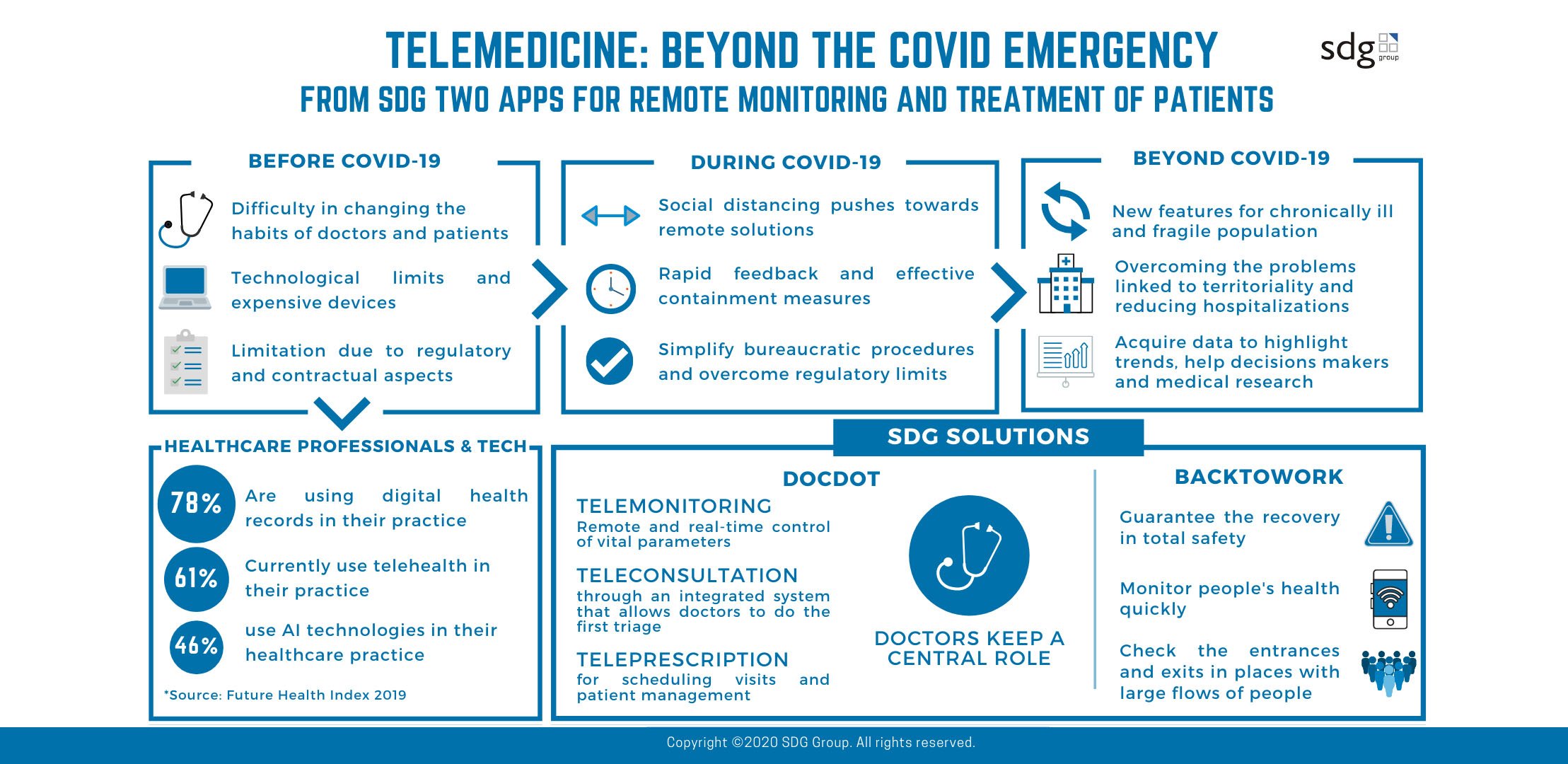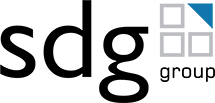TELEMEDICINE BEYOND THE COVID EMERGENCY
In this context, telemedicine has been growing fast. Telemedicine is the combination of medical and IT techniques, developed to provide remote assistance services. Certainly, this is not an absolute novelty, but telemedicine, before Covid-19, was hard to establish due to a complex context characterized by many standards and laws.
During the novel Coronavirus’ pandemic, the benefits of telemedicine became even more evident, favouring the development of new technological solutions, not only to support doctors and patients in the fight against the virus.
In this situation of great urgency, SDG Group has focused its work on the opportunities offered by the application of Artificial Intelligence in telemedicine: under the supervision of the Global CEO Luca Quagini, it has dedicated its best resources for the development of two solutions that guarantee different applications in many contexts.
“Pre-Covid” telemedicine
Covid, in the health sector as in other areas has accelerated processes that had been going on for some time. “Before this acceleration – explained Luca Quagini – the diffusion of these technologies had been limited both by the habits of doctors and patients, and by some regulatory and contractual aspects. Remote visits were not equivalent to those in the presence. From this point of view, the emergency led the central health services regulators to draw up some guidelines which, once implemented by the local institutions, are allowing to solve the situation”.
In addition to regulatory issues, however, there were technological limits that SDG managed to overcome, also thanks to the support of cutting-edge technological partners in this field. “There were still no solutions that could monitor the patient’s vital parameters remotely, in real time and accurately, without the connection of specific medical device – explained Quagini -. Often the patient had to collect the data independently and report it to the doctor. Alternatively, the patient had to have specific tools to be applied to the smartphone or mobile devices. These, however, are often expensive and make the usability more complex for the user who than prefers traditional methods. Our solutions, on the contrary, aim to make teleconsultation and monitoring extremely simple and without the need for any further device besides your smartphone “.

“DocDot”: doctors are still the protagonists
DocDot was born to provide a remote telemonitoring, teleconsultation and teleprescription service during the Covid emergency. “It is the first application that we have finalized, shortly after the outbreak of the pandemic – says Quagini. – We managed to transform an experimental product developed by an Israeli startup into a system immediately applicable in different contexts. We did it thanks to the help of our medical advisors and our data scientists, who together with a team of about twenty visual analytics experts, have allowed us to develop DocDot”.
DocDot integrates different technologies in a single solution. “It integrates, among other components, a photoplethysmography app. It allows remote real-time monitoring of vital parameters for the diagnosis of respiratory problems such as oxygen saturation, respiratory rhythm, heart rate and heart rate variability. It works simply using the smartphone camera and an artificial intelligence system, which transforms signals into measurements”.
However, that’s not all: “We have developed an integrated system, consisting of an assisted teleconsultation system and a dashboard, able to collect the measures, process them and extract the indications necessary for a first triage. Then DocDot allows to define a schedule of visits and patient management. SDG offers the technological solution, the infrastructure, the data management support and the modelling of advanced analytics algorithms for analysis and preventive uses”.
This is not the umpteenth attempt to replace human with “machine”, quite the opposite!
“The doctor is still the protagonist. Ours solution is available for doctors: doctors invite the patients to download DocDot and it is always up to them to carry out the analysis of the measurements and the teleconsultation. Artificial intelligence and data alone are not enough. The philosophy is exactly the opposite of the “Dr. Google” approach, with which many inquire about health issues nowadays. It’s also different from the assistance systems with more or less qualified call centres and chatbots: you cannot joke about health. The doctor’s competence and responsibility is fundamental”.
“Back to work”: return to work (and not only) in total safety
The slow and gradual recovery hides numerous pitfalls. SDG worked also on another solution, “BacktoWork”, designed to guarantee a return to work and meeting places in total safety. “In this case – explains Quagini – the focus is on checking the state of health to monitor the entrances to or exits from specific places, such as workplaces. BacktoWork collects some measurements relating to the state of health, carried out in real time and in about 30 seconds, to check that people meet specific requirements”.
With this application, SDG aims to create an integrated system, with a subscription cost of a few Euros that varies according to the number of users: “For organizations there is the possibility of integrating BacktoWork with the corporate detection system, thus offering immediate control of the business context, able to report potential risk situations”.
From doctors to companies: different applications and targets
Areas of applications are different and transversal to many sectors.
“At the moment – Quagini recounts – DocDot has aroused the interest of the World Health Organization, of General Practitioners, of various regional health systems. In addition, the world of insurance has shown itself to be very interested in these practices, to add it to their prevention and assistance products and services. Its usefulness goes far beyond the Covid emergency”.
BacktoWork, on the other hand, has a more defined target: “Large companies, structures with large flows of people such as hotels or tourist attractions, stations and airports, events and so on. The sectors are many indeed”.
Beyond the Covid-19 emergency
The accuracy of the applications is growing and some countries has certificated DocDot as a medical device. “We are also working in Europe and the United States to obtain the necessary certifications. The goal is to implement our solution, with some measurements that will make it even more useful and functional even outside the Covid emergency. “
The idea, in fact, is to extend the functionality of the app also for the chronically ill and the part of population defined as fragile, like the elderly. “There is also an important topic of reducing costs for the health system and for insurance, with remote prevention, monitoring and assistance interventions that reduce hospitalizations.”
In addition, there is an important concept linked to territoriality: guaranteeing immediate care even for those who live outside urban context and therefore far from large hospitals. “In these contexts – explains Quagini – our solution offers great value. Centres and foundations dedicated to the treatment and assistance of some specific therapeutic areas are contacting us. “
Last, but not least, are the topics of creating a database and the value of aggregated and analysed data. “There is interest from everyone, both in the public and in the private sector – concludes Quagini – to understand the trends of the health system as a whole: statistical analyses of the health of people, always respecting privacy, offer important information on several levels, both on that of governance and on that of medical and pharmaceutical research “.


